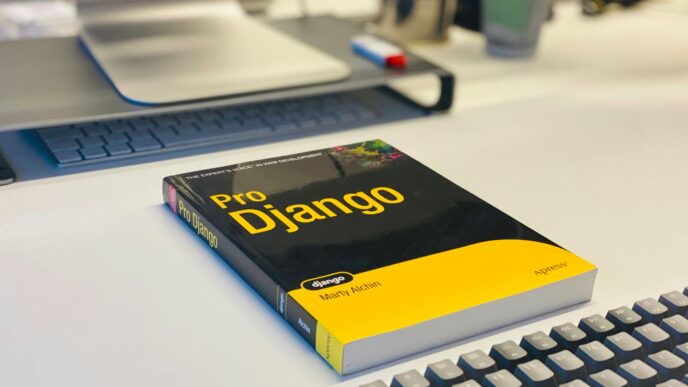Getting ready for coding interviews can feel like a big challenge, but with the right plan and practice, you can definitely boost your chances of doing well. LeetCode is a really popular website for practicing these kinds of interviews. This article will walk you through how to use LeetCode to get better at coding, just like someone who taught themselves programming and then landed a job at a big tech company. We’ll talk about why preparation matters, good ways to practice, common mistakes to avoid, and how LeetCode fits into finding a job.
Key Takeaways
- LeetCode is a big deal in tech interviews because it helps you practice a lot of different coding problems.
- Start with the basics: make sure you really get data structures and algorithms down before moving to harder stuff.
- Don’t just jump into coding. Spend time understanding the problem first, then plan out your solution.
- Always think about how efficient your code is. Can you make it faster or use less memory?
- Practice consistently, do mock interviews, and learn from how others solve problems to really get good.
Understanding the LeetCode Interview Landscape
LeetCode has become a staple in the tech interview process, and it’s important to understand why and how to use it effectively. It’s not just about memorizing solutions; it’s about developing problem-solving skills. Let’s break down the key aspects of the LeetCode interview landscape.
Why LeetCode Dominates Technical Interviews
Why is LeetCode so popular? Well, for starters, it provides a standardized way to assess a candidate’s coding abilities. Companies use it because it’s a relatively efficient way to filter candidates based on their problem-solving skills and knowledge of data structures and algorithms. It allows for a somewhat level playing field, where everyone is assessed on the same types of problems. Plus, many engineers are already familiar with the platform, making it a convenient choice for both interviewers and interviewees. It’s also a great way to enhance their skills and land a job.
Navigating Different Problem Categories
LeetCode problems are categorized in several ways: by data structure (arrays, linked lists, trees, graphs, etc.), by algorithm (dynamic programming, greedy algorithms, binary search, etc.), and by difficulty (easy, medium, hard). Understanding these categories is key to structuring your study plan. For example, if you know you’re weak on graph algorithms, you can focus specifically on those problems. You can also view questions asked in interviews with companies like Google, Microsoft, or Amazon.
Leveraging LeetCode for Company-Specific Prep
One of the best things about LeetCode is that you can filter problems by company. This means you can focus your preparation on the types of questions that are frequently asked by the companies you’re targeting. While it’s not a guarantee that you’ll see the exact same questions, it gives you a good idea of the company’s preferred problem-solving style and the areas they prioritize. It’s also worth checking out company-specific discussion forums and LeetCode interview experiences to get even more insights.
Building a Robust Foundation for LeetCode Interview Success
So, you want to crush those LeetCode problems and land your dream job? Awesome! But before you jump into the deep end, it’s super important to build a solid base. Think of it like building a house – you can’t start with the roof, right? You need a strong foundation first. This section is all about getting those basics down so you can tackle anything LeetCode throws at you.
Mastering Core Data Structures
You absolutely must know your data structures. Seriously, this is non-negotiable. We’re talking arrays, linked lists, stacks, queues, hash maps (dictionaries), trees, and graphs. Understand how they work, when to use them, and their time and space complexities. Don’t just memorize – understand! For example, when would you use a linked list over an array? What are the trade-offs? Knowing this stuff will make your life so much easier when you’re trying to solve problems. You can find study guides that will help you with this.
Essential Algorithms for LeetCode Interview Challenges
Okay, you’ve got your data structures down. Now it’s time for algorithms. We’re talking sorting algorithms (bubble sort, merge sort, quicksort – know the differences!), searching algorithms (binary search is your friend), and basic graph algorithms (breadth-first search, depth-first search). Again, understanding is key. Don’t just copy and paste code – know why it works. Practice implementing these algorithms from scratch. It’ll help you solidify your understanding and make you a better problem-solver. Big-O notation is also important. Make sure you understand the complexities of time and space because this is a commonly requested interview topic. You should explain how your solutions compromise performance.
Starting with Foundational Easy Problems
Alright, you’re armed with data structures and algorithms. Now, resist the urge to jump straight into the hard problems! Start with the easy ones. Seriously. This isn’t about showing off; it’s about building confidence and getting comfortable with the LeetCode platform. Work through the easy problems to practice structuring your code and paying close attention to the problem descriptions, even though they are sometimes complicated. Focus on comprehending the problem-solving process rather than employing brute force or resolving arbitrary problems. Think of it as warming up before a big game. Plus, you’ll probably learn something new along the way. Don’t underestimate the power of the easy problems!
A Systematic Approach to LeetCode Interview Problems
LeetCode isn’t just about blindly solving problems; it’s about developing a methodical approach that you can apply to any coding challenge. It’s like having a toolbox filled with the right instruments, and knowing exactly when and how to use each one. Let’s break down how to tackle those problems strategically.
Deconstructing the Problem Statement
First things first: read the problem carefully. I mean really carefully. Don’t skim! Small details can completely change the solution. Pay attention to the input and output formats, and any constraints mentioned. It’s like reading the instructions before assembling furniture – skip this step, and you’re in for a bad time. Consider these points:
- What is the problem asking you to do, in simple terms?
- What are the inputs? What data types are expected?
- What are the expected outputs? What format should they be in?
- Are there any constraints on the input size or values?
Strategizing Your Solution Before Coding
Don’t jump straight into coding! Take a moment to think about your approach. Consider different algorithms or data structures that might be suitable. Sketch out a rough plan on paper or a whiteboard. Think about the time and space complexity of your potential solutions. It’s like planning a road trip – you wouldn’t just start driving without a map, would you? Think about the key LeetCode coding patterns that might apply.
Identifying Edge Cases and Constraints
Edge cases are the sneaky little things that can break your code. What happens if the input is empty? What if it contains negative numbers? What if it’s extremely large? Think about these scenarios and make sure your solution handles them gracefully. Constraints can also guide your choice of algorithm. If the input size is small, you might be able to get away with a less efficient algorithm. But if the input size is huge, you’ll need to be more careful. Consider these examples:
- Empty input (e.g., an empty array or string)
- Null or invalid input
- Very large input values (potential overflow issues)
- Duplicate values in the input
- Negative values (if the problem doesn’t explicitly forbid them)
Optimizing Your LeetCode Interview Solutions
Okay, so you’ve got a solution that works. Great! But in a LeetCode interview, that’s often just the first step. Interviewers want to see that you can write code that’s not only correct but also efficient. This section is all about taking your working solution and making it shine.
Analyzing Time and Space Complexity
This is huge. Understanding Big-O notation is absolutely key. You need to be able to look at your code and explain how its runtime and memory usage scale as the input size grows. Can you identify the bottlenecks? Are you using any unnecessary loops or data structures? For example, nested loops often lead to O(n^2) time complexity, which might be a red flag. Be prepared to discuss trade-offs – sometimes, you can reduce time complexity by using more memory, and vice versa. It’s about making informed decisions.
Refining Your Code for Efficiency
Once you know where the inefficiencies are, you can start optimizing. This might involve:
- Choosing the right data structure: A hash map can provide O(1) lookup time, while a list might require O(n).
- Reducing unnecessary calculations: Can you precompute some values or reuse results?
- Using built-in functions wisely: Some built-in functions are highly optimized, but others might hide inefficient operations.
- Avoiding redundant loops: Can you combine loops or use a more efficient algorithm?
It’s also worth considering different algorithmic approaches. Could dynamic programming or a divide-and-conquer strategy lead to a more efficient solution? Don’t be afraid to experiment and compare different approaches. Remember to review your responses to improve effectiveness.
Testing and Debugging Strategies
Optimized code is useless if it doesn’t work correctly! Thorough testing is essential. Don’t just rely on the example test cases provided by LeetCode. Think about edge cases, large inputs, and unusual scenarios. Write your own test cases to cover these situations. Use a debugger to step through your code and understand how it’s behaving. Learn to identify common bugs, such as off-by-one errors or incorrect loop conditions. If you’re struggling to find a bug, try simplifying your code or adding more print statements to track the values of variables. Mock interviews offer practical experience in debugging under pressure.
Advanced LeetCode Interview Techniques
Tackling Dynamic Programming Challenges
Dynamic programming can seem scary, but it’s really about breaking down problems into smaller, overlapping subproblems. The key is recognizing when a problem can be solved using optimal substructure and overlapping subproblems. I remember struggling with the knapsack problem until I realized I could build up a table of solutions from smaller knapsacks. It’s all about identifying the recurrence relation and then deciding whether to go top-down (memoization) or bottom-up (tabulation). Bottom-up is often more efficient because it avoids recursion overhead. Practice is really important here. Start with the basics like Fibonacci and climb stairs, then move on to more complex problems like edit distance and longest common subsequence.
Graph Algorithms for Complex Problems
Graph problems are everywhere in interviews, and knowing your graph algorithms is a must. We’re talking about breadth-first search (BFS), depth-first search (DFS), Dijkstra’s algorithm, and minimum spanning trees. BFS is great for finding the shortest path in an unweighted graph, while DFS is useful for exploring all possible paths. Dijkstra’s is your go-to for shortest paths in weighted graphs, but remember it doesn’t work with negative weights! For minimum spanning trees, you’ve got Prim’s and Kruskal’s algorithms. I always try to visualize the graph and think about which algorithm best fits the problem’s constraints. Don’t forget to consider different graph representations like adjacency lists and adjacency matrices, and how they affect the time complexity of your algorithms. Understanding graph traversal techniques is super important.
System Design Fundamentals for LeetCode Interview Prep
System design questions might seem out of place on LeetCode, but they’re becoming increasingly common, especially for more senior roles. These questions test your ability to think about the big picture: scalability, reliability, and performance. You should be familiar with concepts like load balancing, caching, databases (SQL vs. NoSQL), and message queues. It’s not about knowing every detail of every system, but about demonstrating that you can think through the trade-offs and make reasonable design decisions. For example, if you’re designing a URL shortener, you need to consider how to handle a large number of requests, how to store the mappings between short and long URLs, and how to ensure that the system is available even if some servers go down. Here’s a quick rundown of key areas:
- Scalability: How does your system handle increased load?
- Availability: How do you ensure your system stays up and running?
- Consistency: How do you manage data consistency across multiple servers?
- Latency: How do you minimize response times?
Effective Practice Strategies for LeetCode Interview Mastery
LeetCode isn’t just about solving problems; it’s about building a skillset. You need a plan to make the most of your time and effort. Think of it like training for a marathon – you wouldn’t just run 26 miles without any preparation, right? The same goes for LeetCode. Let’s look at some ways to get the most out of your practice.
Consistent Practice and Spaced Repetition
Consistency is key. It’s better to do a little bit every day than to cram for hours once a week. Spaced repetition is also a great technique. Don’t just solve a problem once and forget about it. Revisit problems you’ve struggled with after a few days, then again after a week, and so on. This helps solidify your understanding and improves retention. I find that setting aside even just 30 minutes each day makes a huge difference over time. It’s all about building that muscle memory and reinforcing the concepts. For example, you could use a flashcard app to remind you to revisit certain problem types. This is a great way to improve your coding interview skills.
Mock Interviews and Peer Coding Sessions
Solving problems on your own is good, but it’s not the same as solving them under pressure, with someone watching. Mock interviews are invaluable. Find a friend, a colleague, or even use an online service to simulate a real interview. This will help you get used to explaining your thought process, writing code under time constraints, and handling unexpected questions. Peer coding sessions are also beneficial. Working with someone else can expose you to different approaches and help you identify weaknesses in your own coding style. Plus, it’s just more fun! Consider joining a study group or finding a coding partner to make the process more engaging. You can even focus on BClub CC dumps together.
Learning from Others’ LeetCode Interview Solutions
Don’t be afraid to look at other people’s solutions. It’s not cheating; it’s learning. After you’ve tried to solve a problem on your own, take a look at the solutions provided by other users. Pay attention to different approaches, coding styles, and optimizations. You might discover a more efficient algorithm or a cleaner way to write the code. However, don’t just copy and paste the solution. Make sure you understand why it works and how you could have arrived at it yourself. It’s also helpful to read the discussions and explanations provided by other users. This can give you valuable insights into the problem and the different ways to solve it. This is a great way to master LeetCode.
Beyond the Code: Acing the LeetCode Interview
LeetCode isn’t just about writing code; it’s about showing you can think clearly, handle pressure, and learn from your mistakes. It’s about presenting yourself as someone who’s not only skilled but also a great addition to the team. Let’s look at what it takes to shine beyond just getting the right answer.
Communicating Your Thought Process Clearly
Explaining your reasoning is often as important as the solution itself. Interviewers want to see how you approach problems. Don’t just jump into coding. Start by outlining your understanding of the problem, the different approaches you’re considering, and why you’re choosing a particular one. Talk through your code as you write it, explaining each step and the logic behind it. If you get stuck, verbalize your thought process – what you’ve tried, what you’re considering next, and why you think it might work. This shows problem-solving ability and communication skills, even if you don’t arrive at the perfect solution immediately.
Handling Interview Pressure and Nerves
Interviews are stressful, and it’s normal to feel nervous. The key is to manage that stress so it doesn’t derail you. Here are a few tips:
- Practice under pressure: Simulate interview conditions by setting time limits and minimizing distractions. This helps you get used to performing when you’re feeling stressed.
- Take a moment to breathe: If you feel overwhelmed, it’s okay to pause, take a deep breath, and collect your thoughts. A few seconds of calm can make a big difference.
- Acknowledge your nerves: It’s okay to say, "I’m a little nervous." Being honest can actually help you relax.
- Focus on the problem: Instead of worrying about the interviewer’s judgment, concentrate on the task at hand. Break the problem down into smaller, more manageable parts.
Post-Interview Reflection and Improvement
The interview doesn’t end when you walk out of the room (or close the video call). The real learning happens afterward. Take some time to reflect on your performance. What went well? What could you have done better? Did you struggle with a particular type of problem? Did you communicate effectively? Use this feedback to identify areas for improvement and focus your future practice. Review the problems you struggled with, look at other people’s solutions, and try to solve them again. This post-interview reflection is how you turn each interview into a learning opportunity and get better over time.
Wrapping Things Up
So, there you have it. Getting good at LeetCode, and really, at coding interviews in general, isn’t some magic trick. It’s more about sticking with it, being smart about how you practice, and not giving up when things get tough. You’ll hit some problems that just don’t make sense at first, and that’s totally fine. Everyone does. The main thing is to keep at it, learn from your mistakes, and celebrate the small wins. Before you know it, you’ll be looking back at how far you’ve come, and those tricky interview questions won’t seem so scary anymore. You got this.
Frequently Asked Questions
Why is LeetCode so important for coding interviews?
LeetCode is super important for coding interviews because lots of big tech companies use its style of problems. Getting good at LeetCode helps you show off your problem-solving skills and makes you feel more ready for those tough interview questions.
How should I start if I’m new to LeetCode?
Start with the basics! Focus on understanding simple data structures like lists and maps, and key algorithms like sorting. Then, try easy problems on LeetCode to get comfortable before moving to harder ones.
What’s a good way to tackle a new LeetCode problem?
When you get a problem, first, read it carefully to understand what it’s asking. Then, think about different ways to solve it before you even write any code. Don’t forget to consider weird situations or limits on the numbers you’re working with.
How can I make my LeetCode solutions better?
Always think about how fast your code runs (time complexity) and how much memory it uses (space complexity). Try to make your solutions as quick and efficient as possible. Testing your code with different inputs helps a lot too.
What are the best ways to practice for LeetCode interviews?
Practice often, but don’t just do random problems. Try to space out your practice sessions and revisit problems you found hard. Doing fake interviews with friends or mentors can also really help you get better at explaining your thoughts.
Besides coding, what else matters in a LeetCode interview?
It’s not just about writing code; you also need to talk through your ideas clearly during the interview. Stay calm, even if you’re nervous. After the interview, think about what went well and what you could improve for next time.














